Do you struggle with maintaining proper form while performing a lever full squat? Don’t worry, you’re not alone! Many beginners face this same challenge during their workouts. It’s understandable to feel overwhelmed or intimidated when attempting a new exercise. However, it’s important to remember that this problem is often due to a lack of understanding of the proper technique. In this blog post, we’ll break down the steps and provide helpful tips to assist in performing a perfect lever full squat. By the end, you’ll feel confident and excited to incorporate this exercise into your routine.
Lever Full Squat (Machine) Summary
- Primary Muscles: Quadriceps
- Secondary Muscles: Adductor Magnus, Gluteus Maximus, and Soleus
- Equipment: Squat Machine
- Mechanics Type: Compound
- Force: Push
- Utility: Basic

Lever Full Squat (Machine) Instructions
- Stand with your feet hip-width apart and toes slightly pointed outward.
- Grip the lever securely with both hands and hold it in front of you at chest level.
- Inhale, bend your knees and lower your body down into a squat position.
- Exhale and drive through your heels to stand back up to the starting position.
- Repeat for desired amount of reps.
Video Tutorial
Lever Full Squat (Machine) Muscles
Target (Agonist)
Synergists
- Adductor Magnus
- Gluteus Maximus
- Soleus
Dynamic Stabilizers
Stabilizers
- Erector Spinae
- Levator Scapulae
- Trapezius – Middle
- Trapezius – Upper
Antagonist Stabilizers

Benefits of Lever Full Squat (Machine)
The Lever Full Squat (Machine) exercise is an effective way to target the Quadriceps muscle. This exercise helps to strengthen the Quadriceps and improve overall balance in the lower body. The Lever Full Squat (Machine) can help to improve muscle coordination, reduce the risk of injury, and increase muscle endurance. By performing this exercise regularly, you will be able to reduce the risk of lower body injuries and improve your overall performance. Additionally, the Lever Full Squat (Machine) is an effective way to build muscle mass in the Quadriceps muscle and improve overall strength. This exercise can also help to improve posture and balance, as well as help to increase flexibility in the lower body.
Tips for Performing Lever Full Squat (Machine)
Taking the time to learn and incorporate the Lever Full Squat into your regular workout routine can be a great way to increase strength and improve overall fitness. With its ease of use, anyone can quickly get started with the exercise and begin to reap the benefits of improved strength and balance. Below, we have compiled a list of tips to help you get the most out of your Lever Full Squat workout.
- Make sure to maintain an upright torso throughout the exercise by engaging your core muscles and keeping your chest up. This will help to ensure that you are using the right muscles during the movement and not relying on momentum.
- Control the descent of the exercise by taking your time and lowering your body until your thighs are parallel with the floor. This will help to maximize your range of motion and reduce the risk of injury.
- Drive through your heels to stand up from the squat while maintaining tension in your glutes and hamstrings to ensure that you are using the right muscles during the exercise. This will also help to build strength and improve muscular endurance.
Benefits and Tips Video
Frequent Mistakes To Avoid
Before we dive into a list of mistakes to avoid while performing Lever Full Squats, let’s take a step back and recognize why it is important to do this exercise correctly. Lever Full Squats are an excellent way to build strength and power in the lower body, which can help you improve overall athletic performance and reduce the risk of injury. However, if done improperly, Lever Full Squats can cause serious harm to your body, so it is important to understand the correct form and avoid common mistakes.
- Not using proper form: It is important to ensure that the hips are fully extended at the top of the movement and that you are not leaning forward. This is to ensure that the muscles of the legs are doing all of the work, not relying on momentum or other muscles to complete the lift.
- Lifting too much weight: It can be tempting to load the bar with too much weight, but this could lead to injury. Start with a light weight, and gradually increase as your strength improves.
- Not engaging the core: To ensure stability throughout the exercise, it is important to engage your core muscles, as they help to support your lower body and keep your spine in a neutral position.
Find More Machine Exercises Here
Variations and Complementary Exercises
If you’re looking to switch up your routine, or if the Lever Full Squat (Machine) isn’t available to you, here are some alternative exercises that will help you work similar muscles:
Lever Squat (Machine)
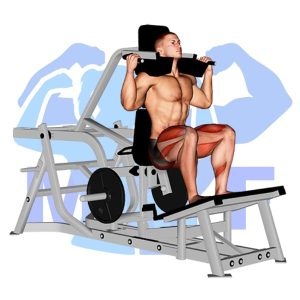
The Lever Squat (Machine) is a great complement or alternative to the Lever Full Squat (Machine). It works the same muscles as the Lever Full Squat, but with a different range of motion. The Lever Squat focuses on the quads and hamstrings, whereas the Lever Full Squat focuses on the glutes and hips. Furthermore, the Lever Squat allows for greater range of motion in the knees and ankles, which can help reduce the risk of injury. The Lever Squat is a great way to add variety to your workout routine and is an excellent exercise for toning and building muscle.
Prisoner Squat
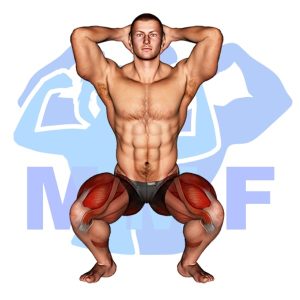
Prisoner Squat is an excellent complement or alternative to the Lever Full Squat (Machine) exercise. It is a calisthenic bodyweight exercise that requires no equipment and can be done anywhere. The exercise involves standing with your feet shoulder-width apart, placing your hands behind your head, and then squatting down as low as possible. This exercise works the same muscles as the Lever Full Squat (Machine) but also engages the core muscles, making it a great way to strengthen and tone the entire body. Additionally, it can be done at a higher intensity than a Lever Full Squat (Machine), allowing for an even more effective workout.
Smith Machine Clean Grip Front Squat

The Smith Machine Clean Grip Front Squat is an effective and complementary alternative exercise to the Lever Full Squat (Machine). It is a compound exercise that targets the quads, glutes, and hamstrings and requires the lifter to maintain a vertical torso while keeping the elbows up. This exercise can be performed with a clean grip, which eliminates the need for straps and allows for greater range of motion. It also reduces the risk of injury by providing a stable base for the barbell. The Smith Machine Clean Grip Front Squat is an excellent exercise for those looking to increase their leg strength, power, and size.
Check Out These Top Machine Exercises
Smith Machine Frankenstein Squat
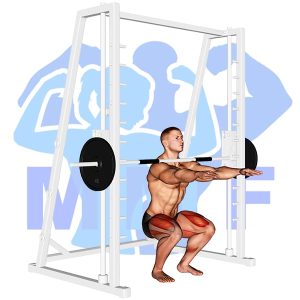
The Smith Machine Frankenstein Squat is a great alternative or complementary exercise to the Lever Full Squat (Machine). It requires the use of a Smith Machine to perform the squat, and it involves using an alternating grip on the bar while keeping it close to the body. The Smith Machine Frankenstein Squat works many of the same muscles as the Lever Full Squat, with the added benefit of more stability, as the Smith Machine reduces the risk of injury. It is also a great exercise for targeting the quads, glutes, and hamstrings, and can be used to increase flexibility and strength in the lower body.
Smith Machine Front Squat

The Smith Machine Front Squat is an excellent complementary or alternative exercise to the Lever Full Squat (Machine). This exercise is performed in a standing position with the barbell held on the shoulders and the feet slightly wider than shoulder-width apart. The barbell is then lowered in a controlled manner until the thighs are parallel to the floor and then raised to the starting position. This exercise works the quadriceps, hamstrings, glutes and core muscles and provides an effective workout for the lower body. Additionally, it allows for greater stability and control than a regular free weight squat and is an ideal exercise for anyone seeking to build strength and muscle in their lower body.
Smith Machine Squat

The Smith Machine Squat is a great complementary or alternative exercise to the Lever Full Squat (Machine). It allows you to perform a squat motion while focusing on the quads and glutes. The Smith Machine Squat is performed with a barbell that is affixed to a track, allowing you to perform squats with a fixed range of motion and less risk of injury. As the barbell is fixed, you can focus more on proper form and technique. This exercise can be performed with heavier weights and is a great way to increase strength and power. It also helps to build stability and balance throughout the entire body.
Find More Legs Exercises Here
Opposing Complementary Exercises
To complete a full-body workout, it is important to include exercises that work opposing muscle groups. The following exercises are complementary to the Lever Full Squat (Machine) and target the opposing muscle groups:
Barbell Sumo Deadlift
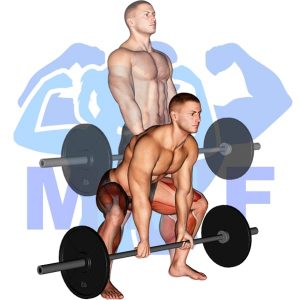
The Barbell Sumo Deadlift is an excellent complementary exercise to the Lever Full Squat (Machine). The Barbell Sumo Deadlift works the muscles in the lower body and back, while the Lever Full Squat (Machine) works the muscles in the lower body and front. This combination of exercises helps to create balanced muscle development and strength throughout the lower body, which is essential for overall health and fitness. The Barbell Sumo Deadlift emphasizes the inner thigh and outer hip muscles, while the Lever Full Squat (Machine) works the quads, glutes, and core. Additionally, this combination helps to increase overall stability and balance, which is beneficial for improving posture and performance in sports.
Dumbbell Deadlift
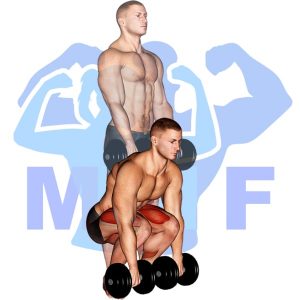
The Dumbbell Deadlift is a great complementary exercise to the Lever Full Squat (Machine) because it works the opposing muscle group. The Dumbbell Deadlift focuses on strengthening the posterior chain, specifically the hamstrings, glutes, and lower back. This exercise helps to stabilize the core, as well as build strength in the lower body. On the other hand, the Lever Full Squat (Machine) focuses on strengthening the quads and core muscles. These two exercises, when combined, create a balanced workout that strengthens both the anterior and posterior chain.
Barbell Clean and Press

The Barbell Clean and Press is a great complementary exercise to the Lever Full Squat (Machine). The Barbell Clean and Press works the upper body muscles, specifically the shoulders and arms, while the Lever Full Squat (Machine) works the lower body muscles, specifically the glutes and quadriceps. This combination of exercises helps to build a balanced and strong physique by targeting opposing muscle groups. The Barbell Clean and Press is an important exercise for improving overall strength, power, and explosiveness. Not only will it help to build muscle mass, but it will also help to improve coordination, balance, and agility.
Master the Lever Full Squat Today!
The lever full squat is a killer exercise that requires strength and technique. It’s a great way to develop lower body strength and explosive power. But it can also be dangerous if you don’t execute it properly. That’s why it’s important to start with lighter weights and focus on perfecting your form. Once you have the technique down pat, you can gradually increase the weight and the intensity. Make sure to keep your back straight, your knees aligned with your toes, and your heels flat on the ground. With practice and patience, you’ll be able to master the lever full squat in no time.
References: Wikipedia | ExRx.net | PubMed.gov | Comprehensive List of Legs Machine Exercises




